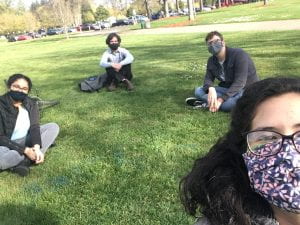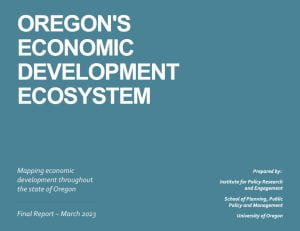Oregon is unique given what falls inside its borders; there is a little bit of everything. The Oregon landscape ranges from coastal environments, to lush valleys, mountain ranges, forests, and deserts. Local economies are driven by diverse industries such as agriculture, forestry, tourism, manufacturing, technology, and more.
Economic development organizations, services, and practitioners across the state work to support Oregon’s economy and meet the needs of local and regional communities. Mapping the economic development ecosystem in Oregon provides an opportunity to increase awareness and collaboration across sectors and jurisdictions.
How did the study evolve?
In 2019, IPRE faculty initiated discussions with representatives from OEDD (Oregon Economic Development Districts) about the potential to study Oregon’s economic development ecosystem. This work builds on statewide economic development needs assessments IPRE conducted in 2012 and 2017. After considerable discussion, a team of graduate students led by IPRE faculty member Melissa Graciosa dug into the project in 2021. The project had three objectives:
- Define baseline data on the economic development ecosystem.
- Provide a resource that defines roles, services, and economic development organizations at the state level and regional level.
- Support planning for a resilient and equitable economy.
The research team quickly found out that very little research exists on economic development ecosystems. Thus, the team created a definition and a framework for the study:
An economic development ecosystem looks at how the complex network of economic development organizations, services, populations, and supporting infrastructure is interconnected and related.
In short, viewing economic development as an ecosystem applies a systems thinking approach to the field.
What did the study find?
The IPRE research team identified 859 unique economic development organizations (EDOs)providing 1,358 services. Seventy percent of these organizations were local, 59% provide targeted and direct services, and 52% of them are non-governmental organizations. Other key findings include:
- 41% of organizations report having one or fewer full-time staff; 76% have five or fewer
- 76% had annual budgets of less than $500,000
- 82% agree that EDOs must coordinate to be effective; 64% report that coordination is difficult but 84% view it as worth the effort
- Conditions disincentivize collaboration and organizations frequently compete for funding and staff
- Capacity and funding were identified as key barriers to collaboration
- Complex geographies and misaligned service territories make collaboration difficult
- EDOs want more interaction and support from the state
- Equity, inclusion, and resilience are emerging as focal areas for many organizations
- EDOs want to better connect with local and minority-focused community development organizations
What does IPRE recommend?
The Ecosystem Mapping project is an important first step in better understanding how economic development activities are structured in Oregon. The report is intended to inform a deeper dialog about how to best implement economic development activities in the state. IPRE made three primary recommendations:
- Develop and embrace strategies to link, leverage, and align actors, resources, and activities in the ecosystem
- Develop a shared vision for economic development and encourage stronger state and regional leadership
- Establish equity and inclusion as a guiding principle for economic development
This Ecosystem Mapping project is part of IPRE’s ongoing contributions to economic development in Oregon through our Economic Development Administration-funded University Center. We want to thank EDA for their continued support as well as all of the individuals and organizations that participated in this study.
You can access the report by clicking on the cover below. More information about the project is available at the Economic Development Ecosystem Mapping website.

